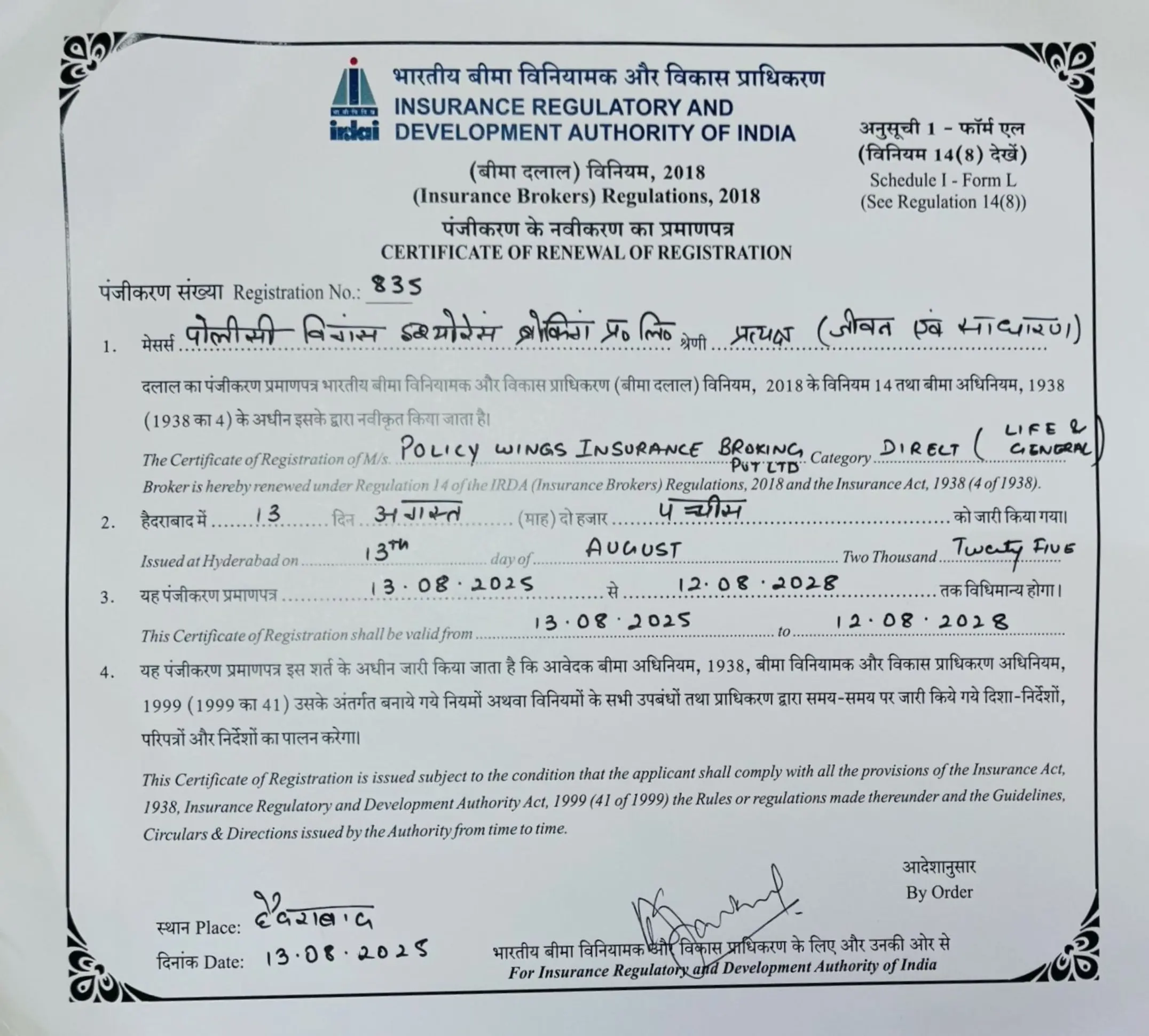Group Health Insurance
Group Health Insurance
Group health insurance is an essential component of any comprehensive employee benefits package. It provides coverage to a group of individuals, typically employees, and their dependents. In this guide, we will explore the advantages of group health insurance for businesses and delve into its key features. Whether you’re a small business owner or an HR professional, this post will help you understand how group health insurance policy works and find the right plan for your employees.
Benefits of Group Health Insurance Policy:

By pooling the risk and negotiating rates with insurance providers, group health insurance plans offer cost savings compared to individual plans.

Group plans typically include a wide range of medical services, such as preventive care, hospitalization, prescription drugs, and more.

Offering group health insurance can be a powerful tool for attracting and retaining skilled employees, giving your business a competitive edge.

Businesses may enjoy tax benefits when providing group health insurance, such as deducting premiums as a business expense.

Access to regular healthcare encourages employees to seek preventive care, leading to healthier and more productive individuals.
How Group Health Insurance Policy Works:
Group health insurance operates by spreading the risk across a pool of employees. Employers choose a plan that suits their budget and coverage needs, and employees contribute to the premiums through payroll deductions. The insurance provider then administers the plan, handling claims, managing networks of healthcare providers, and offering customer support.
The Importance of Group Health Insurance for Employees:
- Providing group health insurance coverage demonstrates your commitment to your employees’ health and well-being.
- It helps attract and retain top talent, as potential employees often consider health benefits when evaluating job offers.
- Group plans typically offer more comprehensive coverage at lower costs compared to individual plans.
Key Features of Comprehensive Group Health Insurance Plans:

Wide Coverage Options :
Comprehensive group health insurance plans offer a range of coverage options, including:
- Inpatient and outpatient services
- Prescription drugs
- Maternity and newborn care
- Mental health and substance abuse services
- Preventive services and wellness programs

Customizable Plans:
You have the flexibility to tailor the insurance plan to suit your team’s specific needs. This allows you to choose the coverage levels, deductibles, and co-pays that align with your budget and employee requirements.

Cost Sharing:
Group health insurance plans typically involve cost sharing between employers and employees. This ensures that the financial burden is distributed, making healthcare more affordable for everyone.
Benefits for Employees :

Affordable Premiums:
Group plans often have lower premiums compared to individual plans since the risk is spread across a larger pool of individuals.

Enhanced Coverage:
Comprehensive group health insurance plans provide extensive coverage, including preventive care, specialist visits, and prescription medications, which might not be fully covered by individual plans.

Network of Providers:
Employees can benefit from a network of healthcare providers, including doctors, specialists, hospitals, and clinics, ensuring they have access to quality healthcare services.
Benefits for Employers:

Improved Employee Morale and Productivity:
Offering comprehensive group health insurance coverage can significantly boost employee morale and job satisfaction, leading to increased productivity and decreased absenteeism.

Tax Advantages:
Employers can enjoy tax benefits by providing group health insurance coverage. Premiums paid by the employer are usually tax-deductible as a business expense.

Attract and Retain Top Talent:
A competitive benefits package, including comprehensive health insurance, makes your company more attractive to potential employees and helps retain current valuable team members
Group health insurance for employees is a vital tool for businesses to provide comprehensive healthcare coverage to their employees. By offering cost savings, attracting top talent, and fostering a healthier workforce, it has become a cornerstone of employee benefits packages. Understanding how group health insurance works and exploring the available options is crucial for businesses of all sizes. By prioritizing the well-being of your employees, you’re not only investing in their health but also in the success of your organization.
Frequently Asked Questions
Consider factors like the coverage options, cost-sharing arrangements, network of providers, and affordability. Consulting with an insurance broker or provider can help you navigate the options and find the best fit for your team.
Group health insurance is not mandatory for all businesses, but some states may have requirements for certain employers. Check your local regulations to determine if you are required to provide group health insurance.
Leading Health Insurance Companies





Latest Blogs
Introduction Life Insurance Corporation of India (LIC) is a household name for life and pension products and many consumers search for “LIC health insurance plans”, “LIC health insurance policy India” or “LIC medical insurance reviews” when shopping for medical cover. Historically LIC has focused on life and savings products rather than standalone health policies, but recent industry and regulatory shifts make this a good time to re-examine what LIC’s role is and what buyers should watch for when comparing health cover. Where LIC stands today (and what’s changing) LIC does not currently dominate the retail health insurance market the way private health insurers do, but it has publicly signalled interest in entering the space by acquiring stakes in a specialist health insurer rather than building a new standalone business from the ground up. This approach would mean LIC-branded health offerings could appear through a joint venture or minority stake in a licensed health insurer, rather than as a direct LIC issued product immediately. At the same time, regulatory action from the Insurance Regulatory and Development Authority of India (IRDAI) and fiscal reforms by the government are reshaping the health-insurance landscape and any LIC foray will be influenced by those rules. Key recent regulatory developments affect waiting periods, coverage of alternative medicine (AYUSH), portability and claim processes; insurers and platforms have been updating product designs to comply. What to expect from an LIC health insurance policy (if/when available) If LIC launches or partners to offer medical cover, you can reasonably expect: Standardised hospitalisation benefits (room rent, ICU, surgeon and diagnostic charges) aligned with IRDAI minimums. Cashless tie ups with a network of hospitals through a third party administrator (TPA) or the insurer’s own network. Optional addons (maternity, outpatient, critical illness riders) offered by most commercial health insurers. These are market norms that any new entrant must follow; product specifics (sum insured slabs, sublimits, copayments) will determine real value. Buying health cover today: practical checklist When comparing policies LIC branded or otherwise focus on the items that determine claim success and long term value: Sum insured and inflation protection choose cover that scales with future medical inflation. Waiting periods for pre-existing diseases check how many years are required before coverage for pre-existing conditions begins. Recent IRDAI guidance aims to reduce unreasonable waiting periods, but individual products still differ. Cashless hospital network and claim turnaround verify the insurer’s network and average claim settlement times. The government is tightening oversight of national claims infrastructure to curb invoice inflation, which should help standardise cashless transactions. Exclusions and sublimits read policy wordings for room rent caps, procedure sublimits and AYUSH coverage. IRDAI’s consumer facing changes are pushing for fewer restrictive sublimits on alternative therapy coverage. Required documents & compliance (quick list) Identity proof (Aadhaar, passport, driver’s licence). Proof of address. Age proof (for eligibility and premium calculation). Medical history / declarations accurate disclosure avoids claim repudiation. These documents and truthful declarations are non negotiable across insurers; portability and renewal benefit from complete records. Recent legal and tax changes that affect premiums A landmark fiscal change in 2025 (implemented by the GST Council and notified by the government) exempted GST on individual life and health insurance premiums effective 22 September 2025. This reduces the effective premium paid by retail policyholders and can make higher cover more affordable. Insurers may, however, adjust commission structures or pricing mechanics as the input tax and accounting impacts are passed through the value chain, so compare final premium quotes. Separately, IRDAI has issued consumer centric guidelines in 2024–2025 aimed at improving transparency, reducing arbitrary waiting periods, ensuring AYUSH coverage without excessive sub-limits and simplifying portability and claims all of which raise the baseline expectations for any insurer offering health plans in India. LIC medical insurance reviews: what reviewers watch Professional reviews of “LIC health insurance” (or any new LIC offering) will typically evaluate: Claim settlement ratio and average claim processing time; Network hospital breadth for cashless service; Pricing vs. comparable private insurers; Policy wordings for exclusions, co-pay and renewability. Because LIC’s brand equity rests on trust and a large customer base, reviewers will pay close attention to how LIC handles post sale service, disclosures and claim disputes. Conclusion If you’re searching for “LIC health insurance plans” or “LIC health insurance policy India”, remember that LIC’s move into health may materialise through a stake in an existing health insurer not necessarily as a direct, standalone LIC policy immediately. Meanwhile, recent regulatory reforms from IRDAI and the GST exemption for retail premiums materially improve affordability and consumer protections across the market. Shop by total cost, wording transparency, network quality and documented claim performance and treat any new LIC health product as you would any other insurer’s offering: read the policy wordings closely and compare final premium and claim terms before you buy.
...Introduction Underinsurance in businesses is one of the most common yet overlooked financial risks faced by companies in India. If coverage limits, terms or valuations don’t align with actual risk, a company may have insurance policies in place but still be at risk. To find these gaps, match coverage to operational realities and make sure your policies actually protect you in the event of a claim, it is imperative to conduct a business insurance audit in India. Knowing Underinsurance: It’s Not Just About Low Coverage When the scope of coverage or sum insured is insufficient to cover the actual loss incurred, underinsurance occurs. It usually results from out of date asset valuations, operational changes that aren’t taken into account or a lack of specific coverage for emerging risks in India. It is the insured’s responsibility to declare accurate sums insured and maintain policies up to date; the Insurance Act of 1938 and IRDAI regulations do not automatically prevent underinsurance. In reality, a lot of claims are lowered under the “average clause”, which states that if assets are undervalued, compensation will be lowered proportionately. The Effects of Underinsurance on Indian Businesses Underinsurance can have serious financial repercussions. Due to proportional settlement rules, the insurer may only pay half of the amount if, for instance, your factory’s machinery is worth ₹10 crore but is only insured for ₹5 crore and you sustain a ₹2 crore loss. This strategy has been supported by Indian courts. The average clause was upheld by the court in United India Insurance Co. Ltd. v. Pushpalaya Printers because the insured had assets that were undervalued despite their belief that they were “adequately” insured. Step 1: Conduct a Comprehensive Business Insurance Audit In a business insurance audit in India, all policies of property, liability, cyber, marine, directors and officers (D&O), employee benefits and sector specific coverage are methodically reviewed. Through this process, you can make sure that the policy terms, coverage scopes and sums insured reflect the current state of your business. An audit ought to confirm: Precise asset appraisal (at replacement or reinstatement value) Revised revenue numbers for business interruption insurance Coverage types’ applicability in light of changing risk exposures Step 2: Reassess Asset Valuations Annually Your insurance limits may soon become out of date due to capital investments, inflation and currency fluctuations. Undervaluing assets may be considered misrepresentation since IRDAI requires a fair presentation of risk. Annual valuations help keep your insurance in line with replacement costs, especially for inventory, plant and machinery. Step 3: Review Policy Exclusions and Limitations Underinsurance is caused by both omitted exclusions and inadequate sums insured. Many Indian companies find out too late that their policies do not cover losses from certain risks, such as floods or cyberattacks. Any missing extensions should be found during a policy review, including: Property coverage for earthquakes and cyclones Protection against ransomware and data breaches for online threats Coverage for supply chain interruptions in manufacturing or logistics companies Step 4: Align Coverage with Operational Changes New products, enlarged service areas or new locations all bring new risks as businesses change. These modifications must be reported to the insurer in accordance with the Indian insurance law’s recognition of the principle of utmost good faith. As demonstrated in Satwant Kaur Sandhu v. New India Assurance Co. Ltd., where failure to disclose material facts voids the policy, failure to do so may result in claims being denied. Step 5: Evaluate Business Interruption Coverage Businesses are especially vulnerable to underinsurance when it comes to business interruption (BI) coverage. Since many policies are predicated on antiquated revenue estimates, businesses are left vulnerable during protracted outages. Accurate BI coverage in India ought to show: Present yearly turnover Expected expansion Reasonable turnaround times for operations Step 6: Examine adherence to contractual and statutory insurance requirements Certain industries are mandated to have insurance under the Indian Acts and Laws. For example the Public Liability Insurance Act of 1991 requires specific third party liability coverage for industries that are disastrous, hazardous or catastrophic and the Motor Vehicles Act requires minimum liability coverage for carriers. In order to avoid penalties and ensure that contracts with clients, landlords or lenders are upheld a business insurance audit ensures that all of these legal requirements and compliances are met. Step 7: Track Claims History and Adjust Accordingly Examine whether the terms and coverage limits were adequate if you have had claims within the last 12 months. Trends in claims that are rejected or only partially resolved could point to ongoing underinsurance or misaligned policies. Future disputes are avoided through proactive adjustments. Legal Principles Reinforcing the Need to Avoid Underinsurance When assets are undervalued, Indian courts have consistently upheld insurer’s rights to apply proportional settlement. They also reaffirm the insured’s obligation to accurately and completely disclose risk. Thus, underinsurance can result in disagreements that escalate into expensive litigation in addition to lowering claim payouts. Furthermore, companies still have an obligation to maintain sufficient coverage even though insurers are required by the IRDAI’s Protection of Policyholder’s Interests Regulations to provide clear explanations of policy terms. How to Maintain Adequate Coverage Year Round Avoiding underinsurance is a continuous process. It calls for: Every year, all policies must be audited Revaluations of assets in accordance with market replacement costs When operations change, regular risk assessments are conducted. Speaking with brokers or legal counsel who are knowledgeable about the risks unique to a given industry Businesses can make sure they maintain coverage that actually protects them by instituting these measures. Conclusion In businesses, underinsurance is frequently an undetectable risk until calamity occurs. Businesses can guard against operational failures, legal issues and financial gaps by putting in place a structured business insurance audit India. The most resilient companies view insurance audits as an essential component of strategic risk management rather than as a compliance exercise. In a market that is becoming more unpredictable, this strategy makes sure that coverage changes with the company to safeguard assets, income and reputation.
...Introduction Group personal accident insurance India has become increasingly essential for employers wanting to protect their workforce against unforeseen incidents as there is a high chance of evolving risks and on site injuries where insurance has gained attention as a helpful inclusion in employee benefit packages across organizations of all sizes. Group Personal Accident Insurance Group personal accident insurance (GPAI) is a policy that covers employees altogether against accidental death, permanent disablement and temporary disablement (in many cases). Customised for a group like company staff or association members where this insurance offers financial protection when there is an unpredictable accident. In India where workplace and travel related incidents are common, GPAI provides crucial coverage to lower economic fallout. Significance of Group Coverage for Employers Cost Effective Premiums: Group schemes influence economies of scale which is better than individual accident plans. Insurers usually offer lower per person premiums under group arrangements which makes it inexpensive for employers while increasing employee security. Simplified Administration: Holding on to a single insurance policy instead of numerous individual ones simplifies HR operations. PolicyWings clients can appreciate how group personal accident insurance decreases paperwork, eases onboarding and makes claims processing quick because of systemised coordination. Moral and Competitive Corner: In a competitive job market offering accident insurance shows that an employer values employee well being. This not only increases morale but also enforces retention and attracts talent by differentiating compensation packages. Benefits of Group Coverage for Employees Financial Security after an Accident: If an unfortunate accident results in permanent disability or death then the lump sum compensation eases financial load on families. Access to Interim Income Support: Some policies include temporary total or partial disablement cover which provides income in case of an employee being incapacitated for a period. This type of benefit maintains employees and their families during recovery. Quick Claim Processes: Group policies usually have standardized claim mechanisms which are managed at the employer level which allows employees to file claims easily without navigating complicated individual procedures. What Employers Should Consider When Selecting a Plan Extent of Coverage: Group personal accident insurance has different offers. Employers must check if the policy includes death, permanent and temporary disability and sometimes, medical expenses or daily hospital cash. Wider coverage has prices slightly higher but provides comprehensive protection. Coverage Limits must be Adequate: having adequate coverage limits per employee is essential. Compensation should be relevant to local cost of living, typical wage levels and potential liabilities from accidents. Not insuring rightly could leave families inadequately supported. Inclusions and Exclusions: Policies often exclude risky activities (for example extreme sports or non work related accidents). Employers have to review the list carefully to make sure that the coverage matches employee real world risks particularly in industries like logistics, manufacturing or field services. Record of Claim Settlement: Evaluating the insurer’s reputation for claim processing in India is essential as well. A quick transparent claim experience increases employee trust in the benefit and it also reinforces its value. Add On Features: Optional riders like repatriation of remains, ambulance charges, funeral expenses or education benefits for dependents can enhance policy utility a lot. It’s optional but benefits are usually appreciated by employees. Clarifying Common Concerns One common doubt is whether GPAI overlaps with other employee insurance coverage. In India, many companies provide group health and life insurance and still those policies may not fully cover accidental disability or death arising from nonhealth related causes. Accident specific coverage adds an additional layer of protection customised for sudden and unintended events. Another doubt is whether smaller organizations can afford group personal accident insurance. Yes, they can. Many insurers provide entry level group plans that limit the amount of costs while providing essential protection and they are flexible as well. As the workforce evolves the coverage tiers can balance accordingly. Improving Your HR Benefits Package Converting group personal accident insurance into overall employee well being frameworks strengthens employer branding. When put together with group health, life and wellness offerings then GPAI is a complete trio of risk protection. This strengthens policies marketed under “employee benefit insurance”, “corporate accident policy”, or “accident insurance for employees India”. And proactively communicating these benefits during orientation and periodic HR outreach helps employees understand them which improves perceived compensation value. Advice for Maximizing ROI on GPAI Conduct a risk assessment to adjust coverage to your workplace profile Survey employee concerns around security and financial uncertainty Compare insurer quotes focusing on claim settlement ratios and coverage scope Educate employees on policy particulars especially the claims process Review policy annually to customise benefits or coverage limits as needed Conclusion Group personal accident insurance India offers a cost efficient, morale boosting and administratively effective way to add adequate protection for employees. In circumstances where accidents can ruin lives and livelihoods, this coverage plays a critical role. For employers it’s not just an expense but it’s an investment in workforce resilience and employer brand differentiation.
...Introduction The best thing about running a business is making profits but it’s equally important to protect what you’ve built. You spend years setting up your workplace, what if it gets all damaged overnight by a fire accident or maybe an earthquake? It’s not even easy to think of such a situation. This is why you need commercial property insurance. Sadly, many businesses underestimate the importance of property insurance, because they keep thinking that nothing so bad will happen. But this is life. Risks are unpredictable. One incident and it may cost you lakhs or even crores. Only with the right coverage through commercial property insurance plans you can protect your hard-earned investment. We are here to help you understand why every business, regardless of size, must have commercial property insurance. What is Commercial Property Insurance? It’s a type of insurance that protects your valuable business property against damaging risks like fire, theft, natural disasters or anything that causes loss of property. Not just the building, it also covers the assets inside it like equipment, tools, machinery, furniture, raw materials, finished goods etc Let’s suppose a fire accident happens in your office and it damages your building and destroys your equipment. Now, commercial property insurance will cover the cost of repairs and replacements. Yes, the load will not fall on your pocket. Without insurance, all your savings will go into fixing your office or you might even have to take loans. Why is Property Insurance so Important for Businesses? It doesn’t matter if you own a small shop or a huge factory; it’s your business and your operations rely on it. Damage to the property directly disrupts your business and impacts your income. Property insurance is essential because: It protects all your physical assets in the workspace. It makes sure the business continues even after an accident. It provides the much-needed financial stability during tough times. It doesn’t let your working capital or savings be wiped out for repairs or replacements. In short, without property insurance, all operations will come to a halt after a single bad event. What Do Commercial Property Insurance Plans Cover? While all insurance providers offer different coverage, here’s what most commercial property insurance plans protect from: Buildings and Structures– Workspaces like corporate offices, large warehouses, showrooms and factories. Furniture and Fixtures– All your desks, chairs, shelves and other furniture that’s set up. Machinery and Equipment– Tools & equipment used for manufacturing, heavy machinery and even computers/laptops. Stock and Inventory– Raw materials and finished goods present in the facility and even the goods in transit. Loss of Rent/Income– In case your property becomes unusable due to the damage caused. Natural Disasters– Damaging disasters like heavy floods, earthquakes, storms, large cyclones etc. Man-Made Risks– If there’s fire, theft, riots, strikes or other intentional damage. This is why commercial property insurance plans are adaptable to the different industries it is being taken for. Benefits of Commercial Property Insurance These are the top reasons that convince you to get your property insured: Protection Against Financial Loss: If a disaster, whether natural or man-made, can cause huge financial damage. With insurance in place, there’s no need to pay for any repairs and replacements from your pocket. Business Continuity: When operations are disrupted, it can lead to loss of income. Thankfully, many policies cover the loss of income, thereby making sure that your cash flow isn’t completely stopped. Peace of Mind: The assurance that your property and assets are protected lets you focus on growth with a relaxed mind and you don’t stay worried about unexpected situations. Covers More Than Just Buildings: Remember that insurance isn’t limited to just the physical building. It also covers your finished and raw stock, machinery, furniture and sometimes even electronic data (add-on benefit). Improves Business Credibility: Insured businesses are preferred by banks, investors, and even clients because they seem more stable and reliable. If you have property insurance, it means you take your risks seriously. Who Needs Commercial Property Insurance? Honestly, any business that owns or rents physical space should consider getting it. They could be: Retail Stores & Showrooms– To protect their inventory and display stock. Warehouses– To secure all the goods and raw materials stored in the facility. Manufacturers– They need it to protect their machinery and production equipment. IT Companies– It covers all the office equipment like laptops, servers etc. Restaurants & Hotels– Insurance ensure the kitchens, furniture, interiors and related assets are secure. Not just these sectors, even small businesses like salons, coaching centers and workshops can go for commercial property insurance plans, because risks are there for businesses of all sizes. Common Risks Businesses Face Without Insurance Not having commercial property insurance means your business is exposed to some serious risks like: You have to pay for heavy repair or replacement costs from your own pocket. Customers may go to another business because of operational shutdowns. Risk of bankruptcy, especially if the damage is not easy to recover from. You might struggle with banks or investors due to a lack of credibility now. One accident, maybe due to fire, flood or a major robbery, can affect your years of effort if there’s no insurance. How to Choose the Right Commercial Property Insurance Plan There are a few things that you must keep in mind when comparing commercial property insurance plans: Assess Your Assets– Make a detailed and proper list of all the property, stock and equipment you want to secure. Understand What’s Included and What’s Not– Remember that policies may not cover all kinds of damages. Check Add-ons– You can opt for extra benefits like electronic equipment cover, goods in transit or natural disaster extensions for stronger coverage. Compare Premiums vs. Coverage– Buying the cheapest is not the solution. Focus on value for money. Reassess Regularly– Do update your coverage as your business grows so you’re not underinsured. For example, a sudden electrical fire happens in a small textile factory that damages machines worth ₹37 lakh.
...Introduction After working almost all your life, raising a family and saving for the future, seniors just want to live peacefully and enjoy a comfortable time with their dear ones. But one sudden medical emergency can come with a bill of lakhs and knock out your savings. This scary stress can be avoided by getting a Senior Citizen Health Insurance. Medical care is becoming more expensive and there are often increased health risks with age. But with health insurance for senior citizens, you get financial stability and peace of mind. Here we will discuss why insurance for senior citizens is so important, the benefits it offers and what really makes the best health insurance policy for seniors. Why Do Senior Citizens Need Health Insurance? As we come closer to our retirement years, our bodies are old enough to become naturally more vulnerable to health issues. Routine checkup and certain medications are like part of life and sometimes, there may also be hospitalization. Without proper coverage, these medical expenses can eat away the money that you saved for daily living or even emergencies. Below are some reasons why you must get senior citizen health insurance: Rising Healthcare Costs: Treatment costs in India are growing even faster than general inflation. A simple hospital stay can cost in lakhs and it’s not easy to pay this amount out of pocket. Increased Risk of Illness: There is always a higher possibility of senior citizens suffering from chronic diseases like diabetes, BP issues, heart problems etc. Limited or No Income: Most retired people rely on pensions, savings, or family support for their expenses. Now, a huge medical bill can disturb the financial planning. Peace of Mind: When you have a policy, you can focus on getting treatment and recovery instead of financial stress. Challenges Seniors Face Without Insurance The risks of not having insurance would actually make you understand the true value of insurance: Savings Get Wiped Out: You get hospitalized one time and you’re slapped with a bill of several lakhs. This leaves very little for daily needs. Compromised Treatment: Due to a lack of funds, some families may even delay or choose cheaper alternatives, which affects the recovery of the patients. Burden on Children: When parents don’t have the scope to pay for the treatment, the medical costs fall on children. This only adds up to an already difficult time. Loss of Independence: When elders feel they are dependent, it hurts their dignity as well. Not having senior citizen health insurance means a missing safety net. It can turn your life upside down in medical emergencies. Benefits of Senior Citizen Health Insurance Now we will look at the different ways in which health insurance plans for senior citizens actually help: Hospitalization Coverage: Room rent, doctor’s fees, surgeries and even treatment medicines, a senior citizen health insurance policy takes care of it all. This is such a lifesaver because hospital bills are often a lot higher than expected. Pre and Post-Hospitalization Expenses: Most health insurance plans also cover the cost of prescribed tests, medicines necessary before admission and follow-up visits once the patient is discharged. Cashless Treatment: Most insurance providers have tie-ups with hospitals where seniors can get their treatment without having to pay upfront. Instead of arranging for funds during emergencies, patients can rush for timely medical care. Coverage for Pre-Existing Diseases: Policies designed for seniors usually don’t make them wait for long. Rather, the coverage starts as early as in 1-2 years. Ambulance Charges: The policies also include emergency ambulance expenses. It saves families from sudden expenses that come from the pocket. Day-Care Procedures: There are many modern surgeries that can be completed within 24 hours and don’t require hospital stays. These treatments are covered by insurance for senior citizens. Mental Health Coverage: It’s not only physical health that suffers with age but also mental well-being. This is why some policies also include psychiatric consultations and therapy sessions. Tax Benefits: Section 80D of the Income Tax Act makes senior citizen health insurance tax free and this helps reduce overall tax liability. Key Features to Look for in the Best Health Insurance Policy for Seniors All policies are unique in some way. One may have something the other doesn’t. Look for these features when choosing the best health insurance policy for seniors: High Coverage Amount: The sum insured has to be good enough that it covers major surgeries and hospitalization. Low Waiting Period for Pre-Existing Diseases: A Shorter waiting period means you are eligible to get coverage for your health conditions sooner. No Claim Bonus (NCB): If things go well and you don’t make a claim in a year, certain insurers will also increase your coverage. Cashless Hospital Network: A wide network of hospitals gives patients a higher chance of access to treatment, even in their nearest hospitals. Reasonable Premiums: Though premiums are generally higher for senior citizens but you can always compare different health insurance plans. It gives the best balance between price and coverage. Critical Illness Rider: Some policies allow you to take add-ons for severe conditions like cancer, stroke or organ failure so you get the best treatment. How to Keep Premiums Affordable The high cost of premiums is of the most common concerns about insurance for senior citizens but you can make them more affordable by following these tips: Buy Early: Purchasing early means you have to pay lower premiums while also getting more years of coverage. Opt for Higher Deductibles: When you agree to pay a small part of the claim, it can actually reduce your premium amount. Compare Multiple Plans: You don’t have to settle for the first option because helpful platforms like Policywings help you compare the benefits and costs of different policies side by side. Look for Family Floaters When Suitable: In some cases, getting a family floater policy can also serve the purpose. Individual plans can be more costly. Reducing the Family’s Burden with Senior Citizen Health Insurance
...Introduction Life insurance is hands down one of the smartest steps you can take to secure your family’s financial future. However, the one big question is whether to go for a life insurance term plan or choose from traditional life insurance plans (endowment or whole life policies). People usually find them similar since they’re both part of life insurance but they really work very differently. While one plan is all about providing protection, the other combines double benefits of insurance and savings. For most of us, i could be really confusing to pick between both the options. So let’s make it simple for you to understand and decide. What is a Term Insurance Plan? A life insurance term plan is the most straightforward form of insurance out there. You just need to pay regular premiums and if something happens to you during the policy term, the insurance company will give your family a fixed sum assured. The key points about term plans are: Premiums are low but coverage is high. There’s no maturity benefit. Basically, if you survive the policy period, you don’t get any money back unless you have signed up for the “return of premium” plan. Ideal for those who want maximum financial protection but can’t pay a lot. For example, you may be just but with a life insurance term plan you already have coverage worth ₹1 crore for just ₹10,000 per year. Honestly, this makes your family’s lifelong security cheaper than a Netflix subscription. What is Traditional Life Insurance? Traditional life insurance plans offer protection and savings both. Under plans like endowment or whole life policies, you pay regular premiums. In return, along with life cover, some part of your money also gets invested or saved. As the term ends, you or your family receives a maturity benefit. Important points about traditional plans: The policyholders get both insurance cover and savings/investment returns. For the same amount of coverage, premiums are higher compared to term plans. These plans are highly preferred by those who seek sure-shot returns along with insurance. Now for getting ₹1 crore coverage in a traditional plan, you might pay ₹1,00,000 yearly or even more, which is much higher than a life insurance term plan. Quick Comparison Between Term Insurance and Traditional Life Insurance Feature Life Insurance Term Plan Traditional Life Insurance Plans Coverage Low premium but high cover Lower cover but high premium Premium Typically affordable (₹10k–15k for ₹1 crore) It’s expensive (₹1 lakh+ for ₹1 crore) Savings/Investment Only protection and no returns Insurance with savings both Maturity Benefit None. Though you might get with return of premium plan Yes, you get maturity value or bonuses Flexibility Simple and easy to understand More complex and less flexible Best For People who seek maximum security for their family People who prefer cover + savings both Advantages of Term Plans High Coverage at Low Cost: For a small and affordable premium amount you get a large cover which is perfect if you want to protect your family’s lifestyle. Easy to Understand: There are no hidden conditions or difficult investment terms. Just a simple insurance. Flexibility: To add more protection, you can also buy riders like critical illness cover or accidental death benefit. Peace of Mind: It feels great to know that your family is financially secure even if you’re not around. Limitations of Term Plans You do not get anything (no returns) if you survive the term. You need to invest separately to build your wealth. Advantages of Traditional Life Insurance Insurance + Savings: You get the best of both worlds- protection and future savings. Guaranteed Returns: Plans like endowment and whole life policies are known to provide assured maturity benefits. Good for Conservative Investors: Traditional life insurance plans are a safe choice compared to the risky market-linked products. Limitations of Traditional Life Insurance Very high premiums for providing such low coverage. Returns are not that great compared to other investment options available like mutual funds or PPF. Often, there are tricky terms, conditions and bonus rules that may just confuse the buyers. But Which is Better for You? Ok, so the answer mainly depends on your goals. You must choose a life insurance term plan if: You seek maximum financial protection for your loved ones. You are young and looking for high coverage but at a low cost. You don’t want to combine insurance and investment. You want to invest your money separately like in mutual funds, stocks or maybe FDs. You must choose traditional life insurance plans if: You want a safe savings option with built in insurance. You want to receive guaranteed maturity benefits. You don’t want to separately manage investments. You don’t mind lower coverage but want steady returns. Let’s take an example of two people. Person A buys a life insurance term plan for ₹1 crore. He pays ₹12,000 premium per year and invests the rest of his money (₹88,000) in other avenues (mutual funds and FDs). 20 years later, besides having full protection, he has also built wealth from investments. Person B buys a traditional life insurance plan with ₹1 crore coverage where he gives a premium of ₹1 lakh annually. While he does get insurance and guaranteed returns at maturity, he doesn’t have the flexibility to invest his funds separately. At the end of 20 years, Person A has both a high cover and a considerable investment. However, person B does have cover but only a smaller fixed maturity benefit. Common Misconceptions People Have “Term plans are a waste because you don’t get money back.” Well, you can think of it like car insurance. Here, you pay to get peace of mind. If nothing happens, it’s already good news! “Traditional plans always give the best returns.” Not always. While returns are safe but they are also lower compared to other investment tools. “I should only choose one.” Actually, you can also combine both. Get a term plan for protection and maybe
...Introduction After years of working so hard and saving & planning for everyone else, your retirement years have to be just about you, no? It’s finally time to live on your own terms. However, the question is whether your savings alone would be enough to help keep up with inflation or emergencies. Now, imagine getting the best of life insurance protection and long-term investment growth together. This is possible with Life Insurance Retirement Plans (LIRPs). This retirement insurance plan ensures your loved ones are protected even after you and your money keep growing for the years ahead. Whether you’re just starting your financial journey or you’re close to your retirement, an LIRP offers a structured and tax-efficient way to create financial freedom for the years when you should be relaxing. Read on to know how it works! What is a Life Insurance Retirement Plan (LIRP)? It’s an efficient retirement insurance plan that provides both life coverage and savings. In this, you are required to pay regular premiums. A part of it goes toward your life cover and the remaining gets invested to build more money over time. All this accumulated amount can be later used as your regular income during retirement. Basically, an insurance for retirement is combined with a financial plan that continues to safely grow your wealth. How Does a LIRP Work? LIRP is a flexible and long-term tool for dual benefits. Here’s how this brilliant retirement insurance plan functions: Payment of Premium: You pay a fixed monthly or annual amount. Dual Purpose: The insurance company gives part of the premium to life insurance and invests the remainder. Cash Value Growth: The investment part of your plan grows into cash value over time and it’s also tax-free for as long as it stays invested. Withdraw or Borrow: Once enough savings have grown, you can withdraw or borrow from this amount to fund your retirement years. Death Benefit: In case something unfortunate happens to you, your family still receives a death benefit. Benefits of a Life Insurance Retirement Plan When it comes to offering advantages, the retirement insurance plan goes beyond a traditional life insurance policy. Here’s how: Double Benefit of Protection + Savings It offers life cover for your loved ones and a steadily growing savings fund for you. Ultimately, there will be financial relief during and after your working years. Tax-Deferred Growth The invested amount continues to grow without any immediate tax deductions. You will only be charged taxes when you withdraw. Hence, your investment compounds efficiently. Withdrawal Flexibility The regular pension schemes put a limit on when and how much you can withdraw. But with insurance for retirement, you have more control. You can always access your funds when needed. Guaranteed Returns with Low Risk LIRPs are great for those who prefer stability over risk. They offer predictable returns and keep your capital protected. This is a very reassuring feature of retirement insurance for seniors. Lifetime Coverage You continue to enjoy life cover benefits even after getting retired. If you see it, you secure financial support for your family while your savings also continue to grow. Why LIRP is Becoming Popular in India Today, both life expectancy and healthcare costs are rising and this is pushing people to plan ahead. When you have a retirement insurance plan, it creates a financial shield for you that protects you from the stress of market fluctuations. A lot of people in India are opting for these plans because: They come with the dual advantage of protection and wealth creation. The payout amount is flexible and can be used for both healthcare purposes and regular living expenses. The attraction of the plan increases even more with the tax benefits under Sec 80C and 10(10D). In a nutshell, a LIRP assures that you have sufficient savings for yourself, which has always been a matter of concern among retirees. LIRP vs. Traditional Retirement Plans While both options help you prepare for retirement, they don’t work the same way. Here’s a quick comparison that highlights how LIRPs are different from traditional plans: Feature Life Insurance Retirement Plan (LIRP) Traditional Pension/Retirement Plan Protection Double power of life cover + savings The usual focus is only investment Returns Depending on the plan, it could be market-linked or fixed Fixed and often lower Tax Benefits You get the advantage on both premiums and maturity Limited tax benefits Flexibility You are allowed to make partial withdrawals or take loans Limited access to the funds Ideal For Those who want long-term growth and safety Individuals who don’t prefer risk Who Should Consider a LIRP? These individuals can trust the Life Insurance Retirement Plan and go for it: Working professionals: Those who want to start their savings journey early. Business owners: The ones who prefer flexible investment options. Retirees or near-retirees: People who seek low-risk income along with life cover benefits. Parents or couples: LRIP is very useful for planning long-term family security. In fact, it’s also an excellent choice for those who want retirement insurance for seniors. Why? Because the returns are constant and risk exposure is minimal. Important Things to Do Before Buying Before you decide to go on with a retirement insurance plan, do consider these points: Carefully go through the terms of the policy, charges involved and the lock-in period. Compare the offerings of different insurers. Also pay special attention to their claim settlement ratios. Calculate how long you can keep your money invested to make the most out of the plan. Check if your preferred policy will help you with your future financial goals. It’s totally fine if you have a little extra time before selecting a plan. At least there won’t be any confusion later and you’ll be covered for life. Conclusion A Life Insurance Retirement Plan (LIRP) is a very smart way to build financial independence. It actually keeps you secure through every stage of life. Whether you’re starting early in your career or planning closer to retirement,
...Introduction Buying a car is so exciting. The new smell, the smooth rides. Everything about it seems worth it except for car insurance. Many people see it as a compulsory expense that brings a burden to the wallet every year. However, you just can’t skip it because it’s mandatory in India to have insurance for car. Just by following a few smart and completely legal steps, you can actually cut costs and still enjoy solid coverage. In fact, many car owners are already saving thousands every year! While the internet is full of jargon-filled advice on “how to get the cheapest insurance for car”, we will break it down for you in a very clear and practical way. Why Car Insurance Premiums Feel So Expensive Anyone who has ever renewed their car insurance can relate to the feeling after seeing the premium amount. Every time it seems higher than the previous year, even if you didn’t make a single claim. Here are the reasons why this happens: Rising repair costs: Modern cars have advanced technology. There are smart sensors, digital systems and fancy paint jobs. One small accident and it costs thousands to fix. This makes insurers charge higher premiums. Frequent accidents: India has crowded roads and a lot of traffic, which increases the risk of accidents. When more people make claims, insurance providers spread that burden across all their customers. Add-ons and extras: So many policyholders also buy add-ons without realizing that they will increase the premium. Yes, some features really come in handy but not all of them are necessary for you. Risk-based pricing: Factors like your age, driving history, location and car model also decide the amount. For example, Delhi usually has heavy traffic and thus, higher premiums. All this together can burn a hole in their pocket. But if you be smart about your choices, you can still find the useful and cheapest insurance for car. How to Legally Cut Down Your Car Insurance Costs Premiums feel so heavy on the pocket. But is there any way to reduce them while securing important coverage? Just with perfectly legal ways, you bring down the premium for insurance for car and still stay fully protected. No tricks no loopholes. Compare Before You Commit Even when you book a hotel room, you compare prices. Similarly, you shouldn’t settle for the first quote of insurance for car you get. For the same car, different companies offer different rates and benefits so do a little research. Why it matters: You may dismiss a small difference in premium but counting it all over 5–10 years of owning a car, it can add up to be a big amount. How to do it: Simply use online comparison websites and get multiple quotes. Not just the premium, but also look at what is included and what’s not and customer reviews. Pro tip: The lowest premium is not what you need. Sometimes the cheapest insurance for car may not include roadside assistance or cashless garages that are actually so useful. Seek value for the price. Go for a Higher Voluntary Deductible Many car owners also overlook deductibles. It’s basically the part of a claim you pay before the insurance company comes with its benefits. When you opt for a higher voluntary deductible, you agree to contribute a bit more for a claim. Hence, your insurer gives you a discount on premiums. For example, if you increase your deductible amount from ₹1,500 to ₹4,500, your annual premium could drop by 10–25%. When it works best: If you’re a driver with a good on-road history, this option would suit you. But set your deductible to an affordable amount; otherwise, it becomes a financial strain during accidents. Keep a Clean Driving Record Driving safely is surely the simplest and healthiest way to reduce your car insurance premium. It’s a reward by insurance companies to low-risk drivers because they’re less likely to make claims. Benefits of a clean record: No Claim Bonus (NCB): The year you don’t make a claim, you earn a very good discount. Better premium offers: Your insurer may also give you better rates at renewal. Peace of mind: Obviously, fewer accidents mean overall fewer hassles. Even just by avoiding traffic fines or rash driving, you are seen as a “low risk” driver that brings you closer to the cheapest insurance for car. Choose Add-Ons Wisely Insurance companies will often tempt you with add-ons. Options like zero depreciation cover, engine protection etc are attractive and useful but many of them might just unnecessarily increase your premium. Good add-ons: If yours is a new car, get a zero depreciation cover. If you live in flood-prone areas, get engine protection. Take in the most relevant and practical ones. Not always needed: Add on like roadside assistance may already be offered by your car manufacturer. Similarly, there may be other avoidable ones. Don’t buy all the extras available and rather customize your insurance for car so it fits your lifestyle to reduce your premium significantly. Install Anti-Theft Devices and Safety Features Insurers love cars that have harder to steal features installed. If your vehicle has airbags, alarms, tracking devices or other safety features, it’s going to get you discounts. Why it works: When there’s more security and a lower risk of theft and accident, it also means less financial risk for insurers. How to benefit: If you install an ARAI-approved anti-theft device in your car, some insurers may immediately lower your premium as soon as you give them proof of installation. This is how you can ensure cheaper premiums but also more peace of mind for a safer car. Bonus Tips for Bigger Savings We discussed the five main ways to reduce your premium amount. Here we have a bunch of few more tricks that will help you save money on your car insurance: Renew on time: Late renewals may also lead to losing your No Claim Bonus (NCB). Avoid small claims: Try to pay out-of-pocket for
...







